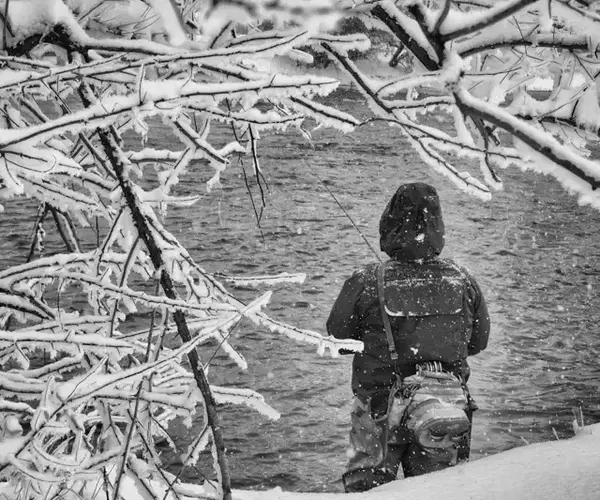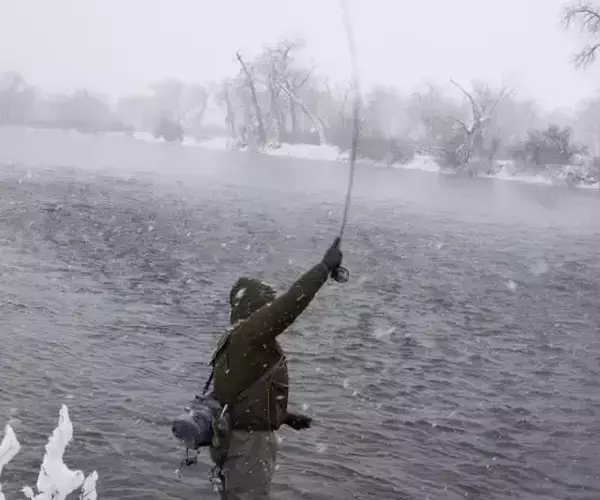Bighorn River Fly Fishing in the Winter
The Bighorn River in winter is one of the most reliable tailwater fisheries in Montana. Starting below Ft. Smith, the river stays open and consistent even when much of the state is locked in ice. Cold water flows out of the dam at a steady pace, keeping the river fishable for miles downstream. From the upper stretches near town down past 13-Mile and toward the Bighorn Access, anglers can expect steady conditions with plenty of water to work. Trout slide into slower edges and deeper runs where food is easy to reach, and with the snow-covered banks and quiet roads, the river feels calm and almost untouched compared to the busy summer season. For anglers willing to layer up and work through chilly mornings and icy guides, the Bighorn is one of the best winter options anywhere in Montana.
Bighorn River Fly Fishing Hatches in the Winter
Winter hatches on the Bighorn are limited, but midges are the most reliable throughout the season. Small black and gray midges come off steadily on calm days, and trout often rise in slower runs and along deeper edges. Keep in mind that fish feed deliberately in cold water. While there isn’t the variety seen in warmer months, having a few midge patterns in sizes 18–22 covers most of the activity, and occasionally a caddis or stonefly nymph may appear near the edges. Focus on presentation and patience, and the steady midges will keep trout active.
Small scuds also make up a large part of the winter diet. These tiny freshwater crustaceans cluster in slow runs, along soft edges, and around submerged rocks or structure, where they stay protected from the cold. Trout often feed on them near the bottom, picking them off steadily when midges are less active.
Bighorn River Fly Fishing Techniques in the Winter
Nymphing is the most reliable method for fly fishing the Bighorn River during winter. A two-fly setup works well, often pairing a scud or sow bug with a small midge dropper under an indicator. Trout hold in slower water, so short, precise drifts are usually more effective than long casts.
River flows remain steady in the winter, which keeps fish holding in predictable areas. Slower edges, seams around submerged structure, and sections with some weed growth are the most productive. Fish feed close to the bottom in these areas when bugs aren't hatching, so presentations that keep flies deep are most effective.
Streamer fly fishing can also produce results in colder months. Small, dark streamers or sculpin patterns fished slowly along weed beds, edges, and deeper pockets can attract larger trout. Controlled retrieves that allow the fly to move slowly and naturally through the water increase the chance of a strike.
Bozeman Fly Fishing Guide Pro Tip:
Floating moss can make split shot difficult to use whenever you are fly fishing the Bighorn River. Applying small amounts of tungsten putty to your nymph rigs provides the weight you need while reducing the chance of getting tangled in vegetation. This allows your flies to reach the feeding zone efficiently and keeps your presentation cleaner, especially in slower edges and weedier sections of the river.
Our Bighorn River Fly Box in Winter
Related Articles From The Montana Fly Fishing Blog

Category: Bozeman Fly Fishing Trip Planning, Tips on Flyfishing Montana Rivers
A Guide to Montana Fly Fishing Trips for Beginners
Post Date: 04/18/2024
Montana fly fishing trips are great for anglers of all skill levels. The vast amount and variety of trout fishing water we have here in Montana makes it particularly great...
Read Article
Category: Bozeman Fly Fishing Trip Planning, Tips on Flyfishing Montana Rivers
Where is the Best Fly Fishing in Montana
Post Date: 03/16/2024
Trout anglers have no shortage of great places to fish. The state of Montana alone boasts enough trout water to keep you busy for several lifetimes. What’s the best trout...
Read Article













